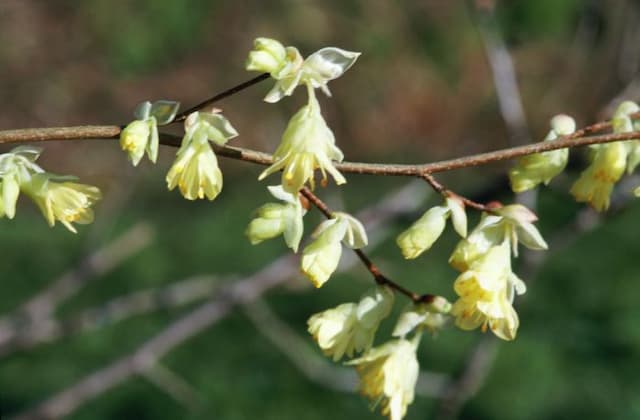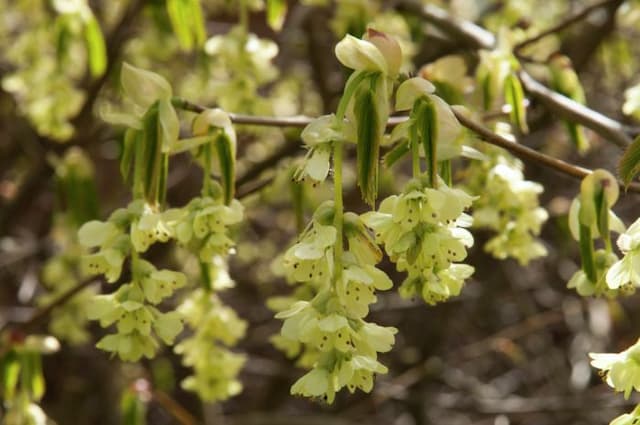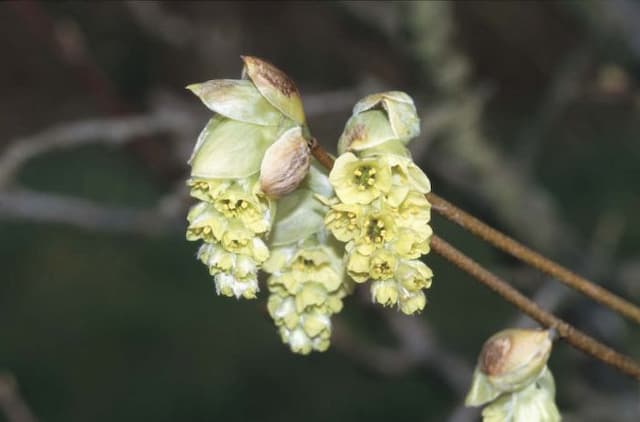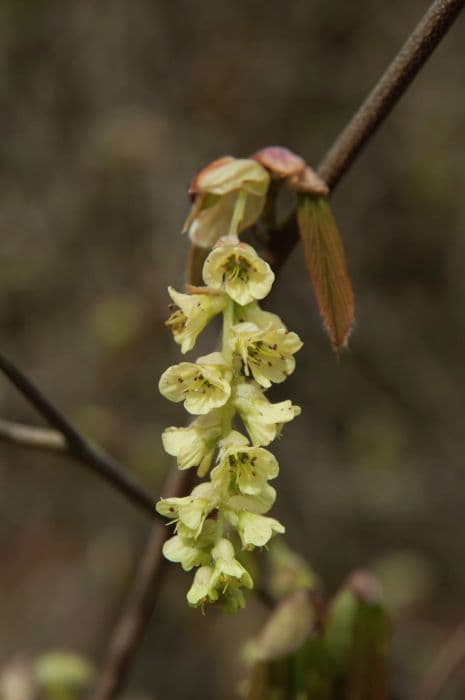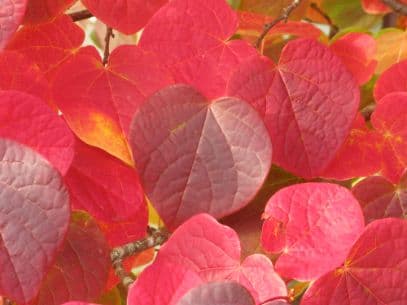Fragrant Winterhazel Corylopsis glabrescens

ABOUT
The plant in question, commonly known as the Fragrant Winter Hazel, is adorned with a delicate display of soft yellow flowers that emerge in drooping clusters, called racemes, before the leaves fully develop. These blossoms emit a subtle yet delightful fragrance that can be an early harbinger of spring. Following the floral show, this plant unfurls its leaves, which are broad, ovate in shape and have a light green hue with a slightly glaucous, or waxy, texture that gives them a somewhat muted appearance. As the seasons progress, the foliage of the Fragrant Winter Hazel may turn to a vibrant yellow, offering a striking visual contrast within an autumnal landscape. The structure of this plant is characterized by a spreading habit, with its stems gracefully arching, giving it an elegant, rounded form that provides an aesthetic appeal even when the branches are bare in the winter months. The bark is smooth and may have a pale grey to light brown color which adds to the plant's charm through different seasons.
About this plant
 Names
NamesFamily
Hamamelidaceae
Synonyms
Fragrant Winter Hazel, Buttercup Winter Hazel
Common names
Corylopsis glabrescens
 Toxicity
ToxicityTo humans
The Corylopsis glabrescens, commonly known as fragrant winter hazel, is not widely recognized for its toxicity to humans. There is limited information regarding its toxic effects, and it does not appear on major lists of poisonous plants. Therefore, it's generally considered to be non-toxic to humans. However, ingesting any plant material can sometimes cause adverse reactions in sensitive individuals or if consumed in large quantities, such as gastrointestinal discomfort. If you suspect ingestion and experience any unusual symptoms, it’s wise to seek medical advice.
To pets
The Corylopsis glabrescens, commonly known as fragrant winter hazel, is not noted for being toxic to pets. It isn't listed as a poisonous plant to pets by major veterinary sources, and there are no specific symptoms of poisoning associated with this plant. However, as with any non-food plant, ingestion by pets may potentially lead to mild gastrointestinal upset such as vomiting or diarrhea due to the novelty and fibrous nature of the plant material. If a pet ingests a part of this plant and shows adverse symptoms, it is best to contact a veterinarian.
 Characteristics
CharacteristicsLife cycle
Perennials
Foliage type
Deciduous
Color of leaves
Green
Flower color
Yellow
Height
5 feet (1.5 meters)
Spread
6 feet (1.8 meters)
Plant type
Shrub
Hardiness zones
6
Native area
Japan
Benefits
 General Benefits
General Benefits- Aesthetic Appeal: Corylopsis glabrescens, commonly known as Fragrant Winterhazel, offers ornamental value with its delicate yellow flowers that bloom in early spring, providing a cheerful display after the cold winter months.
- Habitat for Wildlife: Its flowers provide an early source of nectar and pollen for bees and other pollinators, which are crucial for maintaining healthy ecosystems.
- Seasonal Interest: With its flowers in spring and colorful foliage in the fall, Fragrant Winterhazel adds seasonal interest and variety to gardens and landscapes throughout the year.
- Shade Tolerance: This plant can grow in partial shade, making it a versatile choice for planting under larger trees or in shaded areas of the garden where other plants might struggle.
- Low Maintenance: Once established, Corylopsis glabrescens requires minimal care, making it suitable for gardeners looking for low-maintenance landscaping options.
 Medical Properties
Medical PropertiesThis plant is not used for medical purposes.
 Air-purifying Qualities
Air-purifying QualitiesThis plant is not specifically known for air purifying qualities.
 Other Uses
Other Uses- Fragrance Extraction: The flowers of Winter Hazel can be used to extract essential oils for use in perfumes and aromatherapy, due to their sweet and pleasant fragrance.
- Floral Displays: Winter Hazel's attractive yellow flowers make it suitable for use in floral arrangements, particularly in spring-themed displays.
- Bonsai Cultivation: Winter Hazel can be grown as a bonsai tree, providing an interesting challenge for enthusiasts looking to shape its intricate branching and appreciate its seasonal changes in a miniature form.
- Dye Production: The tannins present in Winter Hazel's bark can be used for producing natural dyes for textiles, though this is not a common practice.
- Photography Subjects: With their early spring blossoms, Winter Hazels are excellent subjects for photographers, particularly those who specialize in botanical and nature photography.
- Education: Winter Hazel can be used in educational settings to teach botany and plant biology, especially regarding flowering patterns and deciduous plants.
- Garden Design: Winter Hazel's early flowering can provide gardeners with an important source of color and visual interest in late winter and early spring, when not many other plants are blooming.
- Habitat Support: When planted in a garden or park, Winter Hazel can provide shelter and food for a variety of wildlife, especially pollinating insects early in the season.
- Cultural Symbolism: In some cultures, the blooming of Winter Hazel may represent the arrival of spring and be used in festivals or artwork celebrating the season.
- Screening Plants: Winter Hazel, due to its size and foliage, can be strategically planted to create natural screens or hedges in garden landscapes, providing privacy and wind protection.
Interesting Facts
 Feng Shui
Feng ShuiThe Winter Hazel is not used in Feng Shui practice.
 Zodiac Sign Compitability
Zodiac Sign CompitabilityThe Winter Hazel is not used in astrology practice.
 Plant Symbolism
Plant Symbolism- Spring Awakening: Corylopsis glabrescens, commonly known as "Fragrant Winter Hazel," often symbolizes the arrival of spring as one of the early bloomers with a fresh and invigorating scent.
- Renewal: The fresh growth and rejuvenation of winter hazel's foliage is frequently seen as a metaphor for new beginnings and renewal of life.
- Hope: Its early flowering can represent hope, as it blooms at the tail end of winter, signifying that warm and brighter days are ahead.
- Charming Innocence: With its delicate flowers and subtle fragrance, winter hazel could be understood to symbolize innocence and the simple, unspoiled beauty of nature.
 Water
WaterThe Winter Hazel should be watered regularly, keeping the soil consistently moist but not water-logged. During active growth in the spring and summer, water the plant about once a week with approximately 1-2 gallons, depending on the size of the shrub and the weather conditions. In the fall and winter months, reduce watering to every two to three weeks or when the top inch of soil has dried out, but ensure it doesn’t dry out completely. If the plant is in a pot, ensure adequate drainage to prevent root rot.
 Light
LightThe Winter Hazel thrives in bright, indirect light and can also tolerate partial shade. The ideal spot would be where it receives morning sun and afternoon shade or dappled sunlight throughout the day. Direct afternoon sunlight can be too intense and should be avoided to prevent leaf burn.
 Temperature
TemperatureThe Winter Hazel prefers temperate climates and can survive in temperatures as low as 0 degrees Fahrenheit, but it is happiest when the temperature ranges between 60 and 75 degrees Fahrenheit. Extreme heat above 95 degrees Fahrenheit can stress the plant, so it should be protected during the hottest parts of the day.
 Pruning
PruningPruning the Winter Hazel can enhance its shape and encourage healthy growth. Prune in late winter or early spring before new growth begins. Remove any dead or damaged wood and thin out older branches to allow light and air to reach the center of the plant. Pruning is generally needed once a year to maintain an attractive form and size.
 Cleaning
CleaningAs needed
 Soil
SoilThe Fragrant Winter Hazel (Corylopsis glabrescens) prefers a well-draining, fertile soil mix with a pH of about 5.5 to 6.5. A mix of loam, peat, and sharp sand in equal parts can create an ideal environment for its roots. Regular incorporation of organic matter is beneficial to maintain soil health and structure.
 Repotting
RepottingThe Fragrant Winter Hazel should be repotted every 2-3 years, or when it outgrows its current pot. Spring is the best time to repot, giving the plant a chance to establish in the new soil before the growing season.
 Humidity & Misting
Humidity & MistingFragrant Winter Hazel thrives in moderate to high humidity levels, typically around 50-60%. It benefits from a moist but not wet environment, so providing additional humidity may be necessary, especially in dry indoor conditions.
 Suitable locations
Suitable locationsIndoor
Place in bright, indirect light and ensure moderate humidity.
Outdoor
Plant in partial shade, shelter from strong winds, and mulch.
Hardiness zone
5-8 USDA.
 Life cycle
Life cycleThe most common name for Corylopsis glabrescens is Fragrant Winterhazel. The life cycle begins with seed germination, occurring in warm, moist soil conditions, often in spring. Seedlings establish themselves quickly in partial shade, developing a root system and foliage. Vegetative growth continues as the plant matures, with Fragrant Winterhazel forming a multi-stemmed shrub. Flowering usually occurs in early spring before the leaves fully expand, with pendulous yellow flowers that are fragrant. After pollination, typically by insects, the plant produces seeds encased in small capsules, completing the reproductive cycle, and these seeds are then dispersed to start the cycle anew.
 Propogation
PropogationPropogation time
Spring
The best time to propagate the Winter Hazel (Corylopsis glabrescens) is typically in the late winter to early spring before new growth begins. The most popular method of propagating Winter Hazel is through semi-hardwood cuttings. This involves taking cuttings from the current year's growth that has started to mature but is not yet fully hard. The cuttings, usually about 4 to 6 inches (10 to 15 centimeters) in length, should have several leaf nodes and be taken just below a node, as this is where roots are most likely to develop. The bottom leaves are removed and the cut end is dipped into a rooting hormone before planting into a mix of potting soil and perlite or sand to encourage drainage. The cuttings should be kept moist and in a warm area with indirect light until roots have developed, which typically takes several weeks. After rooting, they can be transplanted into individual pots or directly into the garden as per the desired landscape design.
